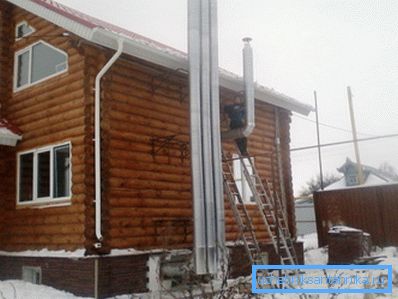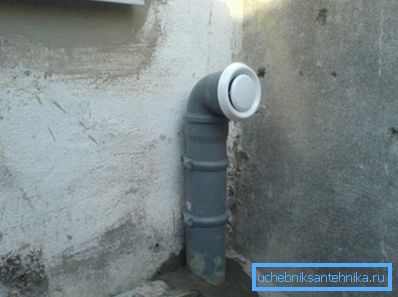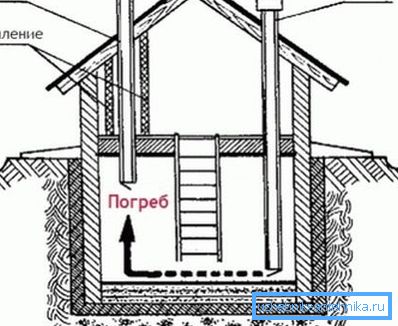Ventilation of the basement of a private house - views and
If you have just become the owner of a house in which there is a basement, or just going to build it, this article will help you to avoid mistakes. In the future, they can affect not only the general microclimate in residential premises, but also cause health deterioration. Properly made ventilation of the basement of a private house will not allow mold and fungi to develop, which will significantly increase the life of the house.

There is a lot of work to be done, but it will mainly be related to the settlement, purchase and installation of fans and pipelines. Want to learn how to do it quickly and without great expense, read the article to the end. We will tell and show you clearly how the ventilation is arranged and point out the necessary actions.
The basement must be dry
The room located under the house should never be wet, otherwise, rising up, the moisture will destroy everything in its path. Let this process go slowly and unnoticed, but in a few months you will begin to feel it.
It will be very good if it is possible to restore damaged communications at low cost, otherwise you will have to disassemble and re-lay everything, and the price of such expenses will be completely different.

By itself, ventilation represents a system of pipes, sometimes mines, which help to achieve normal parameters in a house:
- air exchange;
- humidity;
- temperature
Use the forced option or natural. Consider two systems in more detail to know which one is better to use in our case:
| Forced |
Advantages - independence from external atmospheric conditions, can be adjusted to ensure the quality of air exchange. Disadvantages - the high cost of elements, the complexity of installation. |
| Natural | In this case, you only need to find and install in the basement two pipes - supply and exhaust. The known method for a long time and is still used by many because of its simplicity. Creating a system does not require large financial expenditures. It is carried out due to the difference in temperature outside and inside the building, which creates movement of the air pulling out of the room onto the street, and fresh air comes from there. Alas, very much depends on the wind, which can increase or decrease it. Composition:
The advantage is the simplicity of the device and small financial costs. Disadvantages - it is not always possible to create high-quality air exchange, as there is a large dependence on natural factors. |

For any system on the market today you can find pipes from different materials. Most often purchased from polyvinyl chloride and galvanized tin.
The first ones are usually bought by those who want to install ventilation with their own hands, since installation in this case is simpler. At the same time, metal ventilation channels require certain skills, and their reliability is higher by an order of magnitude.
We collect ventilation in the basement
Before you make ventilation in the basement of a private house, you need to take into account the dimensions of the room, for example, if the area exceeds 50 m2, use the forced option. Otherwise it will be natural enough.
Tip: planning and placement of ventilation should be carried out at the design stage of the house to facilitate its installation in the future.
If you have to install it in the constructed housing, be prepared for the complexity and complexity of the work. Prepare special drilling equipment in advance so that you can make holes in the foundation and floors for ventilation channels.

We do natural ventilation
The instructions below will not cause you any difficulty:
- Prepare a scheme at the design stage of the house. Consider in it the dimensions of the room and the capacity of the ventilation channels. Mark the installation location of the supply and exhaust pipes, indicating their diameter.
Tip: Place the pipes in opposite corners of the basement.
- Place the hole of the exhaust pipe under the ceiling, and the pipe itself out 400-500 mm above the ridge of the roof.
- Install the supply pipe inside the basement as follows:
- the exit edge is located above the floor at the level of 400-500 mm;
- the inlet is 400-500 mm above the ground level outside.
- Recommended for rooms 40 m2 diameter of pipes is 120 mm, then your air exchange will be equal to about 2 volumes of the basement per hour.
Tip: if you use pipes of larger diameter, you can reduce dependence on atmospheric factors and increase the air exchange rate.

Materials for natural ventilation will be:
- plastic or metal pipes;
- deflectors (plastic or metal);
- clamps for fixing pipes.
Tip: install a moisture collector with a tap at the end of the inlet pipe, so you can drain condensate through it, which will accumulate in it.
We do forced ventilation
In this case, it is also impossible to do without a preliminary project, in which there should be calculations for the hourly air exchange of the room and its volumes. The basis of the flow rate at 2 m3/1m2 * hour Multiply the volume of the room by the rate of exchange of air, this will give the parameter the desired fan performance.
The next parameter that helps pick up the fan is the pressure loss in the channel. We recommend choosing a unit with a margin, then such losses in the system will be minimized.

Example for a room in a volume of 70 m3, channel O120 and 10 m long:
- fan power - 120x2 = 240 m3/hour;
- To determine the pressure loss, you need a diagram in which you find the point of intersection between the fan power (horizontal) and the channel diameter (diagonal). Lower the vertical and get 7 Pa for 1 m;
- on 10 m it will be - 7x10 = 70 Pa.
You will need a fan that can pump air within 240 meters.3/ h with a pressure loss of 70 Pa.
Advice: we recommend to contact specialists who can properly develop a coercive system for a large house.
For the basement you can do it yourself. And you can remove the air conditioner or oven from the system.
The device of the ventilation channels does not differ from the installation of natural ventilation, although there are some differences:
- You can install intake and exhaust pipes at a level of 500 mm above the ground;
- indoors, install the fans on the pipes themselves - on the exhaust and intake. You may need to install pressure blocks.

Conclusion
Ventilation of the basement is a necessary condition for the normal and long functioning of the house, therefore such work should be approached responsibly. You must take into account many factors, including the target conditions for the use of the premises and the natural conditions in the region.
Installation of ventilation will not be difficult for you if you possess basic building knowledge and skills.
The video in this article will help you find additional information on this topic.